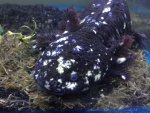Kriztofire
New member
My Axolotl has developed white patches in her skin. Started off with a few, now they are taking over. At first I thought it was an adaptation tinder habitat as I have white and black sand in the tank and she blends in perfectly... the whites marks have developed of several years... I have good water quality and have treated he tank with multicure a couple of times but nothing seems to change...
Is she just changing color or is she really sick?
Is she just changing color or is she really sick?








